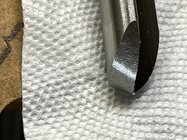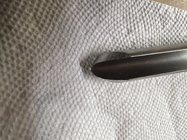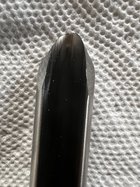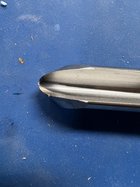I bought a bowl gouge with a standard grind; probably 40 - 45 degrees thinking it would be easy to regrind to the 60 degree Ellsworth grind. It doesn’t seem to be working. Is there a step that must be done first like grinding the nose of the gouge to 60 degrees?
-
June 2025 Turning Challenge: Turn a Wand! (click here for details) -
Congratulations to Dave Landers for "Pod Box" being selected as Turning of the Week for June 2, 2025 (click here for details) -
Welcome new registering member. Your username must be your real First and Last name (for example: John Doe). "Screen names" and "handles" are not allowed and your registration will be deleted if you don't use your real name. Also, do not use all caps nor all lower case.
You are using an out of date browser. It may not display this or other websites correctly.
You should upgrade or use an alternative browser.
You should upgrade or use an alternative browser.
Reshaping Bowl Gouge from Standard to Ellsworth Grind
- Thread starter Randy Heinemann
- Start date
john lucas
AAW Forum Expert
Flip the gouge so the flute is toward the wheel. Grind the wings to the angle you want. Then flip it over and grind the nose angle. You will have flat spots on the top of the wings. Grind the wings until that flat area is sharp. Then blend the wings into the nose.
Thanks. I'll try that tomorrow. Sounds simple but . . . for me, sometimes simple isn't so simple if I haven't done it before.Flip the gouge so the flute is toward the wheel. Grind the wings to the angle you want. Then flip it over and grind the nose angle. You will have flat spots on the top of the wings. Grind the wings until that flat area is sharp. Then blend the wings into the nose.
- Joined
- Feb 28, 2021
- Messages
- 1,620
- Likes
- 1,423
- Location
- Roulette, PA
- Website
- www.reallyruralwoodworks.com
Doug Thompson over at thompson tools has a great video that finally clued me in to how to shape the grind you're after. As John described , but he shows it in video, (ignoring the rest of the sharpening of it, if you already know how you want it sharpened - that is - angle, sweep, etc...)
- Joined
- Apr 27, 2004
- Messages
- 9,213
- Likes
- 5,840
- Location
- Lakeland, Florida
- Website
- www.hockenberywoodturning.com
What John said.
I rest the top of the flute on the edge of the platform and push the tool up the wheel stopping the grinding where I want the wing to end. Then just crudely shape the top of the wing moving the tool up and down the wheel until the side profile looks close.
By jointing the top of the wing the grinding can remove steel to the flute wall where it makes a sharp edge.
I rest the top of the flute on the edge of the platform and push the tool up the wheel stopping the grinding where I want the wing to end. Then just crudely shape the top of the wing moving the tool up and down the wheel until the side profile looks close.
By jointing the top of the wing the grinding can remove steel to the flute wall where it makes a sharp edge.
Randy,
What is the profile shape of the gouge you are trying to convert? Is it Parabolic, U shaped or V shaped? They all don't convert to an Ellsworth-style grind that will perform as his does. A Parabolic like flute shape is best, some V shaped flutes will work and U shaped ..not so much. Perhaps your problem may be that you may have a flute profile that may not convert to begin with. Before grinding away, Why don't you take a picture of the flute and submit?
What is the profile shape of the gouge you are trying to convert? Is it Parabolic, U shaped or V shaped? They all don't convert to an Ellsworth-style grind that will perform as his does. A Parabolic like flute shape is best, some V shaped flutes will work and U shaped ..not so much. Perhaps your problem may be that you may have a flute profile that may not convert to begin with. Before grinding away, Why don't you take a picture of the flute and submit?
A common mistake is that turners do not have the setup right. David used to send out a hand drawing of the dimensions of the setup. I still use the "Vertical Solution" sold by Don Geiger. With that, you can have the right distance and height for the Ellsworth grind. He doesn't make it anymore, he has a "new" vertical solution. I also have one of David's personal gouges, one that he could not sharpen anymore, he sent it to me to have as a guide. I used to have a sign by the gouge that said: David Ellsworth personal gouge, do not use it! Not even in case of an emergency ". Buried somewhere in my computer is a photo of David's drawing, if I find it, I will post it here.
@Dennis Weiner excellent point. Gotta have a profile that will work with the desired grind. U wont work at all, and a narrow V will have too sharp of a nose (tight radius) to work as intended.
Randy, this is the video that Brian is referring to.
The part about regrinding beginning with flipping the gouge upside down begins at around 27:30
but in case you haven't seen it before, the whole video is worth studying.
View: https://www.youtube.com/watch?v=ttYyulsM7wg
The part about regrinding beginning with flipping the gouge upside down begins at around 27:30
but in case you haven't seen it before, the whole video is worth studying.
Thanks for the share Lars.Randy, this is the video that Brian is referring to.
The part about regrinding beginning with flipping the gouge upside down begins at around 27:30
but in case you haven't seen it before, the whole video is worth studying.
View: https://www.youtube.com/watch?v=ttYyulsM7wg
I found it last night and its very informative. Well worth watching and saving. Great Share!
Attached are 4 pictures of the result. The nose angle is almost exactly 60 degrees and, since I used a Tormek with the gouge jig, I believe it is shaped as it is supposed to be. The gouge is a parabolic gouge; exactly the same gouge as my first Crown Pro-PM Ellsworth gouge except I bought it without the Ellsworth grind because it was much cheaper, thinking there would be nothing to regrinding with my current setup. In the end, with everyone's input, I think the result was a good one. I realize there there is a tiny section near the bottom of the grind that is still not exactly an edge, but I will either fix that or leave it for now, assuming it will go away after a couple of sharpenings. It looks almost like the gouge that I bought pre-ground; maybe the side cutting edges slightly longer than the pre-ground, but I doubt this is an issue based on my experience with gouges.
I completely understand that part of the difficulty of the job for me was that I only own a Tormek with the Tormek gouge jig and Tormek's diamond wheels for grinding. Using the gouge jig results in easy, quick, and fool-proof re-sharpening, but also results in an excruciatingly long process for changing a gouge angle or profile. Since I almost never reshape my tools, just maintain the edges on my scrapers and gouges, I have not invested in a regular slow-speed grinder with a Wolverine jig. Really, in general, I just don't need it.
So, I think I was successful, maybe partly by accident and with only a partial understanding of what to do. But it's done and I won't likely ever need to re-shape anothe bowl gouge since I now have 2.
So thanks again.
I completely understand that part of the difficulty of the job for me was that I only own a Tormek with the Tormek gouge jig and Tormek's diamond wheels for grinding. Using the gouge jig results in easy, quick, and fool-proof re-sharpening, but also results in an excruciatingly long process for changing a gouge angle or profile. Since I almost never reshape my tools, just maintain the edges on my scrapers and gouges, I have not invested in a regular slow-speed grinder with a Wolverine jig. Really, in general, I just don't need it.
So, I think I was successful, maybe partly by accident and with only a partial understanding of what to do. But it's done and I won't likely ever need to re-shape anothe bowl gouge since I now have 2.
So thanks again.
Attachments
Dave Landers
Beta Tester
Yeah, you probably don't need that. But maybe consider a cheap (whatever speed, whatever wheels, could even be 6") grinder or belt sander etc for shaping your next tool (by eye). I've got a Tormek T4 - don't use it for lathe tools any more, but do remember that "excruciatingly long process".Since I almost never reshape my tools, just maintain the edges on my scrapers and gouges, I have not invested in a regular slow-speed grinder with a Wolverine jig. Really, in general, I just don't need it.
The abslutely good thing about the Tormek (which, by the way, I bought maybe 15 years ago and nevere used before I began turning about 5 years ago) is that, for sharpening maintenance of gouges and scrapers, I find it a no-brainer. The gouge jig can be set and let that way forever. As for setting the bar's distance from the wheel, it's also set and forget unless I choose to sharpen scrapers (which I don't use much anymore). As an added benefit, since I bought a Tormek diamond wheel and the gouge jig has an accessory to mount some carbide cutters, I can also re-sharpen them; not indefinitely, but the round ones at least once or twice. I also don't use those as much since I discovered an Ellsworth bowl gouge, but there are tasks which I find are easier and quicker for me using a square or round carbide cutter (like forming tenons). That's just me, though . . . easier than taking the time to perfect use of a detail spindle gouge or skew for this task. I'd rather just use the time for actual bowls and hollowing.




